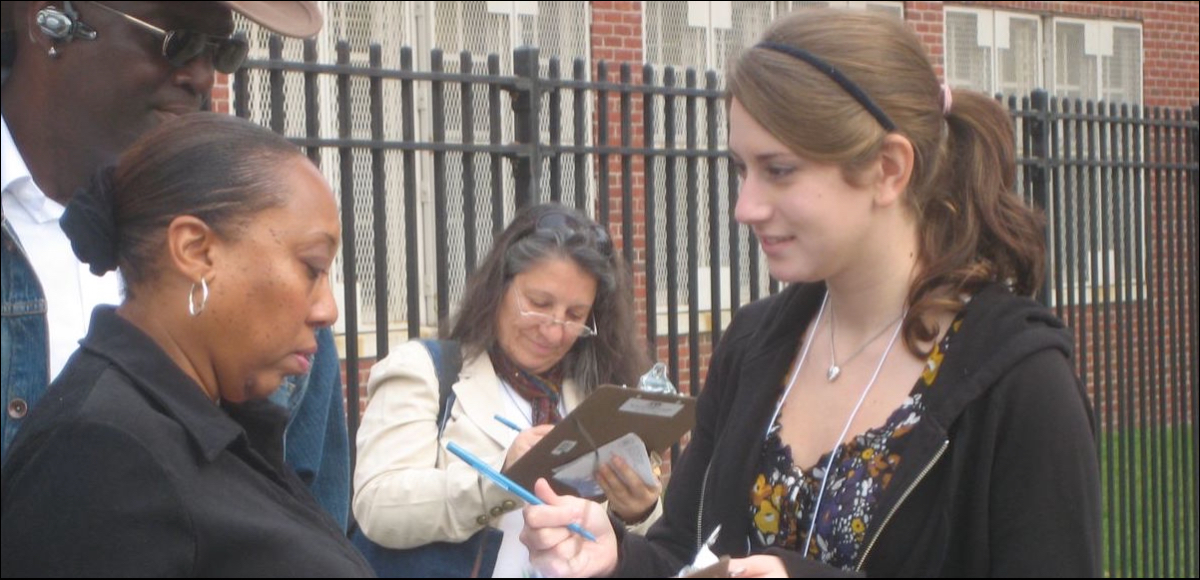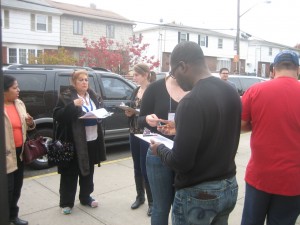I directed communications, fundraising, media relations, recruitment, implementation, data entry, and field work supervision on Election Day in 2006 and 2008. This included recruiting, training, and supervising over 200 pollsters per year at 33 locations citywide.
The press conference to release the findings was held 2 days after the election, making this the first academic poll to analyze the 2008 race. The New York Times, The Daily News, the New York Post, and 30 other media outlets covered the release.
The University Collaborative/New Americans Exit Poll (NAEP) project began in 2000. Since then, we have interviewed over 17,000 New York City voters, including nearly 6,000 foreign born citizen voters leaving their polling places on Election Day in 2000, 2002, 2004, 2005, 2006 and 2008. The result is a unique database of information on the political preferences, attitudes and behavior of New Yorkers participating in recent national, state and municipal elections.
To facilitate the full participation of immigrant voters, surveys are made available in English, Chinese, Spanish, Russian, and Korean translations, and are administered by a trained, multi-lingual survey staff recruited from the city’s ethnic and immigrant neighborhoods.
The funding for the 2008 exit poll was provided by Barnard College, Columbia University, the City University of New York, the New York Latino Research and Resources Network (NYLARNet) at the University of Albany/State University of New York, New York Community Trust, Solidago Foundation and the Four Freedoms Fund.
Some Findings in 2008:
- Immigrants continue to swell the ranks of first time voters in New York City and remain a driving force in the growth of the city’s electorate. Not quite half (41 percent) of all those voting for the first time in this presidential election were foreign born. For the past three presidential elections, three in ten of all foreign born voters were first time voters compared to lower rates among the native born (one in ten in 2000; two in ten in 2004, and one in ten in 2008).
- Our newest citizens make up the largest cohort of foreign born voters. Nearly 18 percent of foreign born voters became citizens during the last two years, and an additional 25 percent of foreignborn voters naturalized between 2000 and 2005; those who naturalized between 2000 and 2005 make up the largest cohort of all foreign born voters.
- Turnout at the polls in New York City increased by about 3 percent over 2004 levels. This increase was driven by higher turnout rates in Black and Latino-majority election districts, and offset by a slight decrease in white majority election districts. Among Latino-majority election districts, turnout increased by 5.4 percent; African American-majority districts increased turnout by 13 percent. Asian American-majority districts, however, evidenced a decrease in turnout of 6.6 percent over 2004 levels.
- In the face of national anti-immigrant sentiment, New York City voters retain a positive attitude toward immigration: more favor increasing the number of immigrants legally permitted to come to the U.S. to live (34 percent) than decreasing it (25 percent), with foreign born voters only slightly more positive in their in their views (38.6 percent) than the native born (33.2 percent).
- In near identical numbers, immigrant and native born voters share the same concerns in this election – they report that their choice for president was motivated primarily by the issues of jobs and the economy, followed by the financial crisis and health care. Immigration itself was the top issue for only a tiny fraction of voters among either group (about one half of one percent a percent of native born voters expressed immigration as their top concern compared to 4 percent of the foreign born).
- Similarly, both groups say jobs and the economy, education, and health care as the top concerns for state government. Equal proportions of people among the foreign and native born want state government to focus on education as much as job creation and financial management.
- With respect to city politics and policy, both groups oppose extending the city’s term limits law in equal proportions (55.5 percent of native born and 55.2 percent of immigrants). When asked whether the mayor and city council should cut services or raise taxes to address the impending budget, only 15 percent of the foreign born and 21 percent of the native born favor cutting city services. Immigrants are slightly more likely to favor government (at all levels) doing more to solve problems (87 percent) than are the native born (83 percent).
- Political parties and campaigns do a poor job of contacting immigrant voters. While immigrant and native born voters are contacted at similar rates by unions (estimated at about 12 percent ) — only about 9 percent of foreign born voters report being contacted by political parties and only about 11 percent by political campaigns, which is roughly half the rate that native born voters report being contacted by parties and campaigns (at about 18 percent and 20 percent, respectively).
- Governor Paterson needs to make inroads to gain the approval of foreign born voters. Foreign born voters approve of Governor Paterson’s performance at lower rates than do native born voters (a 40 percent approval rating from foreign born voters compared to a 50 percent approval rating among native born voters).


